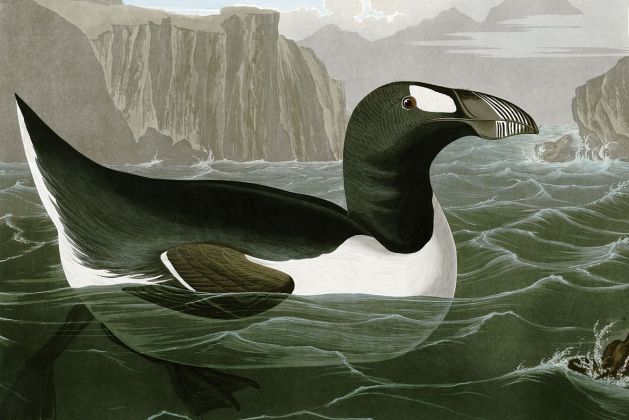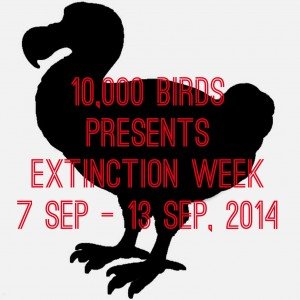
So as some folks may have noticed, it seems that the centenniel of the Passenger Pigeon’s extinction is garnering a bit of press. Good, I say. A lot of folks, including this very blog, are using this as an occasion to memorialize not just the Passenger Pigeon but the extinct birds of the Holocene as a group.
This got me wondering, what was the centennial of the last Great Auk like? Turns out, from what I could find, not particularly ceremonious.
Well, it would have been in 1944… or 1952 or somewhere in between. That’s one reason, probably the biggest reason, why we don’t have centennials for animals that become extinct in the wild. If you choose to consider 1944 the year, most people were a little busy right then. In 1952, at least in the US, no one wanted to be a Debbie Downer.
In 1952, the continental United States was looking pretty good actually on the extinction front. The Heath Hen had gone extinct two decades before, but we could plausibly blame Mother Nature for the final knock-out events and there hadn’t been any loss of cuddly megafauna from our fair shores since then. If something got rare we’d just tuck a preserve around it and keep it as a tourist attraction. The public at large didn’t pay so much attention to our little screw-up on Guam and the whole steady drumbeat of disaster sounding from Hawaii, to the Grand Cayman Thrush or the Imperial Woodpecker or other birds going extinct in remote regions where a mere ‘hasn’t been reported since…’ could drag through the years without any formal punctuation.
Then a little later there was a spot of bother with DDT, but we pulled out of that one ok, with a toolbox that would surely stand us in good stead if we only had the will to use it – legislation and literature, captive breeding programs, nest platforms. We could do it! And we did, for the Peregrine Falcon and Osprey, the Brown Pelican and Bald Eagle.
Then the 80s happened. That was terrible for a lot of people, but especially for the Dusky Seaside Sparrow, a small streaked bird that had the dreadful temerity to dwindle and fade and finally become extinct despite the combined best efforts of the United States government and Walt Disney World. It turned out that all our tools and will didn’t mean we could just keep the bits we liked and drain the rest for highways. And no one had seen the Eskimo Curlew around in a while. Or Bachman’s Warbler. Or the Ivory-billed Woodpecker. And oh crap, you guys, we really have to do something about the California Condor situation right now, but what? Will it work? Because if it doesn’t there are no second chances (Black-footed Ferret aside.)
For a child of those 80s, things seemed fairly hopeless. Everything was going to be extinct – the condors, the whales, the Whooping Cranes, the elephants and tigers, the whole shebang, and that was even if we didn’t get nuked. Good times, I tell you what.
Since then, things feel as though they’ve gotten a bit better. The world has surprised us in the opposite way, with all sorts of critters suddenly popping up unextinct. Part of this is merely media focus – rediscoveries have been happening all along. But with the California Condor now breeding once more in the wild, the Whooping Crane puttering along, and even the whales doing ok, one might hope for cautious optimism… the sort of optimism that prevents paralysis, not the sort that encourages smugness. With global climate change looming ahead, smugness is the last thing we can afford – but we can’t afford paralysis either. And the popular response to the Passenger Pigeon centennial, a few technotopian fantasies about cloning aside, shows that we are not yet meshed in any over-certainty.
So, as the semi-official spokesperson for all things Great Auk, am I jealous that the Passenger Pigeon is getting so much more press? I can’t be, really. If we’d saved the Great Auk up until now, it would be facing at best the same uncertain future as so many other island-nesting alcids. And if we’re all still around in 2044, or 2052, I almost hope we don’t have to have a remembrance, because we’re all hard at work building a world where we don’t have to have these memorials so darn often.
…
Extinction is forever. A species, wiped off the earth, never to exist again. What a horror! What a disaster! What a wrong!
 It is correct, of course, to think of extinction this way during the Holocene Extinction, which we are living through right now. After all, the extinctions have occurred, are occurring, and will occur because of us, people. We have so altered the earth – pumping pollution, moving species around, destroying ecosystems – that many species, dependent upon ecological niches or simply unprepared for an onslaught of unfamiliar organisms with which they did not evolve, have no chance. It is depressing and angering and just wrong.
It is correct, of course, to think of extinction this way during the Holocene Extinction, which we are living through right now. After all, the extinctions have occurred, are occurring, and will occur because of us, people. We have so altered the earth – pumping pollution, moving species around, destroying ecosystems – that many species, dependent upon ecological niches or simply unprepared for an onslaught of unfamiliar organisms with which they did not evolve, have no chance. It is depressing and angering and just wrong.
But, in the wider view of things, extinction is necessary. It is what drives evolution. Extinction is what befalls the species that fails to adapt, to survive, to thrive. Most species go extinct. That is just the hard, cold reality of nature, red in tooth and claw.
This is not to say that we should sit back and let the Holocene Extinction continue. No! We must fight to save every species we can, every ecosystem, every niche.
It is the 100th anniversary of the extinction of the Passenger Pigeon, once one of the most abundant species in the world. In order to raise our awareness, to remind us of what we have lost, and to inspire us to fight for Every. Single. Species. we are hosting Extinction Week here on 10,000 Birds from 7 September to 13 September. Come back, click through, read, learn. And get angry and take action.
…













Leave a Comment